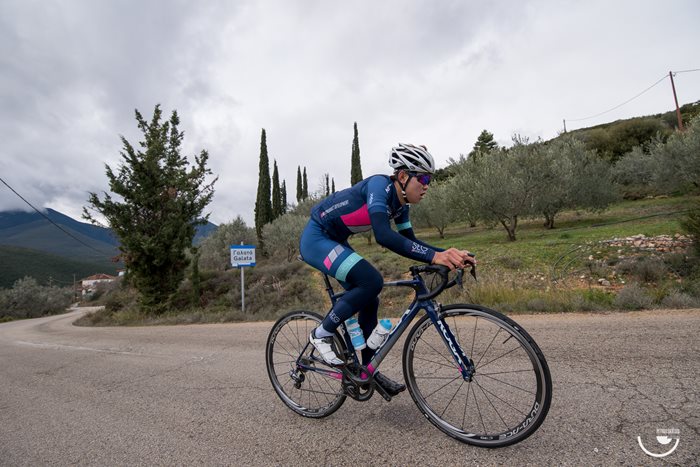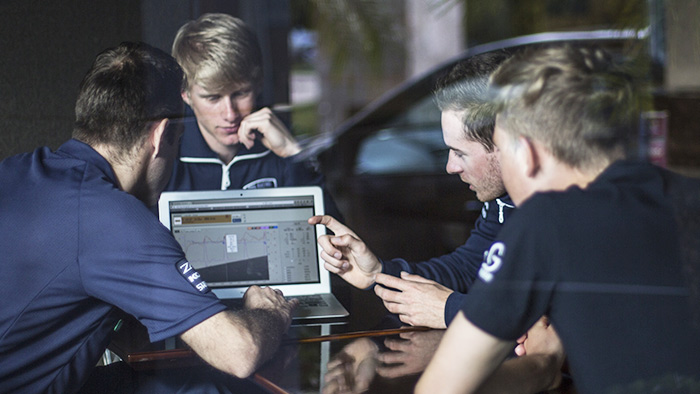With 13 riders from 6 different countries, the SEG Racing Academy may look like most professional cycling teams. However, the goal of the team management is different than simply winning races. “At the SEG Racing Academy, we focus on talent development,” says Academy Manager Bart van Haaren. “By development, we mean to produce professional cyclists that are ready to compete at the top level at all aspects.” Young riders, eager to prove their talent, require a different type of coaching than a seasoned veteran. For the staff of SEG Racing Academy, nurturing that talent takes the right people with the right tools to make the right decisions.
The SEG Academy is supported by the SEG Cycling Agency, (representing riders like Wout Poels, Dan Martin, Niki Terpstra, Sep Vanmarcke, and many others). The Agency works to have the overall vision for each rider, know their strengths and weaknesses, and create the right plan. By combining forces between the Academy and the Agency, SEG makes sure they focus on the talent development process so every rider can make the best out of his capabilities.
With varying levels of experience, ability, and hopes, helping these athletes achieve their dreams is no easy task. That task falls on several coaches and managers at SEG. Along with van Haaren, Performance Manager Michiel Elijzen and four Performance Coaches plan the training, run the logistics, create the strategies, and perform all the intangibles that help these athletes continue to improve.
Rider Management
Performance Coach Vasilis Anastopoulos is tasked with season planning, creating the day to day training of the riders, and tracking progress. Using data from each rider, he gains insights that allow him to modify each rider’s schedule as needed. With each rider competing to make the jump to the next level, the details matter greatly. “I have being using TrainingPeaks for the last five years,” he says. “I consider it to be my best assistant when prescribing and evaluating my riders’ progress. Without this software I would be blind and I would be guessing how my riders respond to the training load and how they perform during the races.”
One of the biggest concerns for the athletes is overtraining. With young and highly motivated riders, often it is a case of holding them back rather than pushing them forward. “Given the fact that we are dealing with young riders, it’s important to monitor their daily workload in order to evaluate their work and avoid the overtraining syndrome,” comments Anastopoulos. “The Performance Management Chart (PMC) is a valuable tool that allows us to track their fitness and adjust the training workload and recovery when needed.”
Developing 13 different riders is a challenge. With varied goals and abilities, it is critical for the SEG coaches to quickly understand what makes each rider progress. These riders have a limited window of opportunity to catch the eye of the bigger teams. The more effective their training is, the more they progress, and the more chance they have of making the jump to the World Tour.
For Team SEG, it is simply a matter of finding what works for each rider. “Every rider is unique, they respond differently to a specific training session,” remarks Anastopoulos. “By using all the tools that TrainingPeaks gives me, we can decide what session fits to everyone early in the season and modify his Annual Training Plan (ATP) accordingly. For example, some riders are well responders to H.I.I.T. (High Intensity Training), while some others perform better by following a high volume of training.”

Educating Riders
Planning the training is only part of the equation of course. It is the ability of the rider to perform the training sessions correctly that matters the most. To that end, SEG seeks to educate their riders. “We’re not obsessed about hitting the numbers right away,” comments van Haaren. “Our first concern is to make the riders understand the purpose and the training philosophy behind each session or effort. Our goal is to teach them how to approach and execute correct the exercises.”
Using an early season session, Anastopoulos illustrates the focus on education. “During our winter camp we asked the riders to perform a set of 1 minute efforts all out by starting the effort out of the saddle for 10 seconds and then try to keep the pace for the whole duration of the effort,” Anastopoulos recalls. “The first rider started the effort accelerating for the first 10 seconds out of the saddle and then he sat in the saddle keeping a high pace. He was even able to push harder, reaching his maximum power of the effort, during the last 10 seconds of it reaching a maximum of 842 watts while his Normalized Power® (NP®) was 597 watts or 7.36 w/kg.”

Discussing the second rider, Anastopoulos points out the details of how this workout, while the numbers are impressive, was not done as prescribed. “The second rider started way too fast, reaching a peak power of 1325 at the first 8 seconds of the effort. Then his power dropped significantly and he kept slowing down till the end of the effort,” he comments. “Even though he had a NP of 780 watts or 9.88w/kg the way he delivered the exercise was not as asked.”

Through analysis and discussion, the team is able to educate riders on how to better perform the interval in order to get the right training effect. “It is so important to teach our young riders how to train better and how to analyze their training themselves,” says van Haaren. “Although we have a lot of contact moments, most of the training is done by the riders on their own. TrainingPeaks gives us the opportunity to monitor, educate, and optimize their training.”
These young riders understand that the more they know about their own bodies and the training they are doing, the more they can work effectively towards their goals. Rather than simply having coaches tell them what to do, many of the riders on the team have taken a keen interest in learning how to better use their data and analyze their own power. “We have the privilege to work with some really intelligent riders this year who like to explore all the options that TrainingPeaks can offer,” says van Haaren. “Some even challenge our trainers sometimes by asking trivial questions about their power files. This is exactly what we want, because by doing so, the riders get a better understanding of the trainer’s philosophy behind the training. This allows them to acquire a better understanding of the points that training focuses on.” Learning how to utilize their data gives the athletes more ownership of their future, and gives them a way to continue to grow even after they leave the SEG Racing Academy.
Constant Communication
It’s not just numbers and analysis that allow the team to help the riders. With riders and staff spread across the globe, staying in contact with each rider is critical. “Being able to put Pre and Post-Activity Comments on Training Peaks helps us to stay in touch with our riders all over the world,” Anastopoulos explains. “It’s up to us as trainers to try to explain in detail to each one of them what they ask for before each session. At the same time, we ask the riders to give their feedback of how the session went, if they had any difficulties or if any part of their training was hard to follow.”
This type of daily feedback loop builds trust in the riders that the team is doing everything they can to help them succeed. “The contact between the trainer and the rider becomes more personal in this way, and the riders feel that the trainer is always by his side to analyze their training and respond immediately to their individual needs,” say van Haaren. It also helps the team run efficiently. “At the end of the day, the features in TrainingPeaks saves us a lot of valuable time and resources,” comments van Haaren.
Another reason the team leverages TrainingPeaks is because it allows for a single place for a complete history of each rider. World Tour teams are highly selective of who they bring on, and they no longer rely on word of mouth. Data plays a large role in an athlete’s ability to showcase what they are capable of, and often, teams request seeing long term training data. “It’s getting more common for World Tour teams to ask permission to have a look at a riders TrainingPeaks account as part of their scouting procedure,” says van Haaren. “Therefore, it’s extremely important for our riders to put as detailed as possible how they felt, what they did, etc.”
SEG Racing Academy has a singular focus to develop young riders and help them achieve their dreams of riding at the highest level of the sport. With many different styles, abilities, and expectations, creating the right program for each individual is difficult. However, using detailed analysis and feedback from the riders and consistent communication along with educating the riders themselves, the SEG Racing Academy is able to plan the training and racing that will give each rider the greatest chance at achieving success. As van Haaren puts it, “We just can’t run without TrainingPeaks.”
Try TrainingPeaks Free for 14 Days


